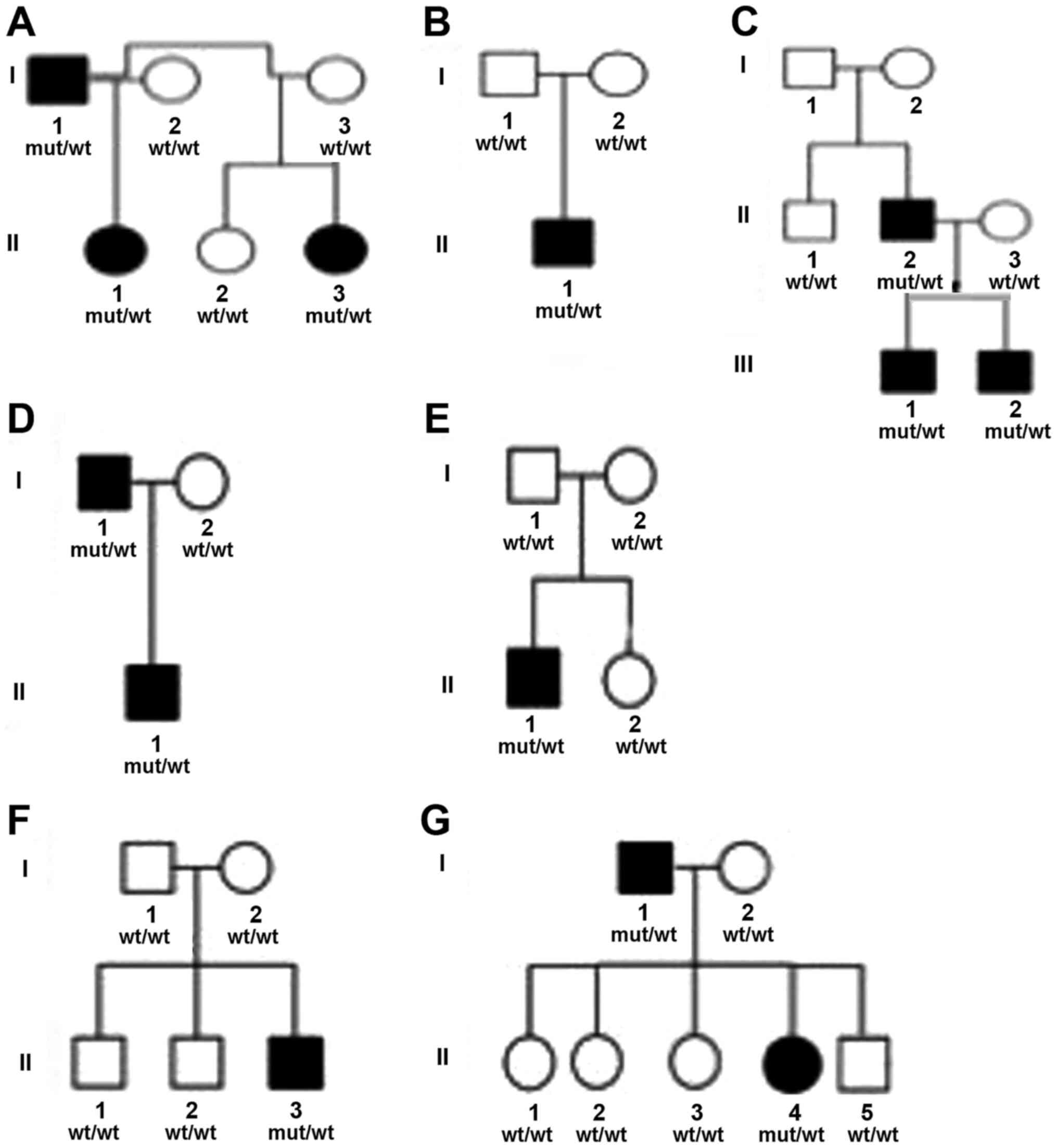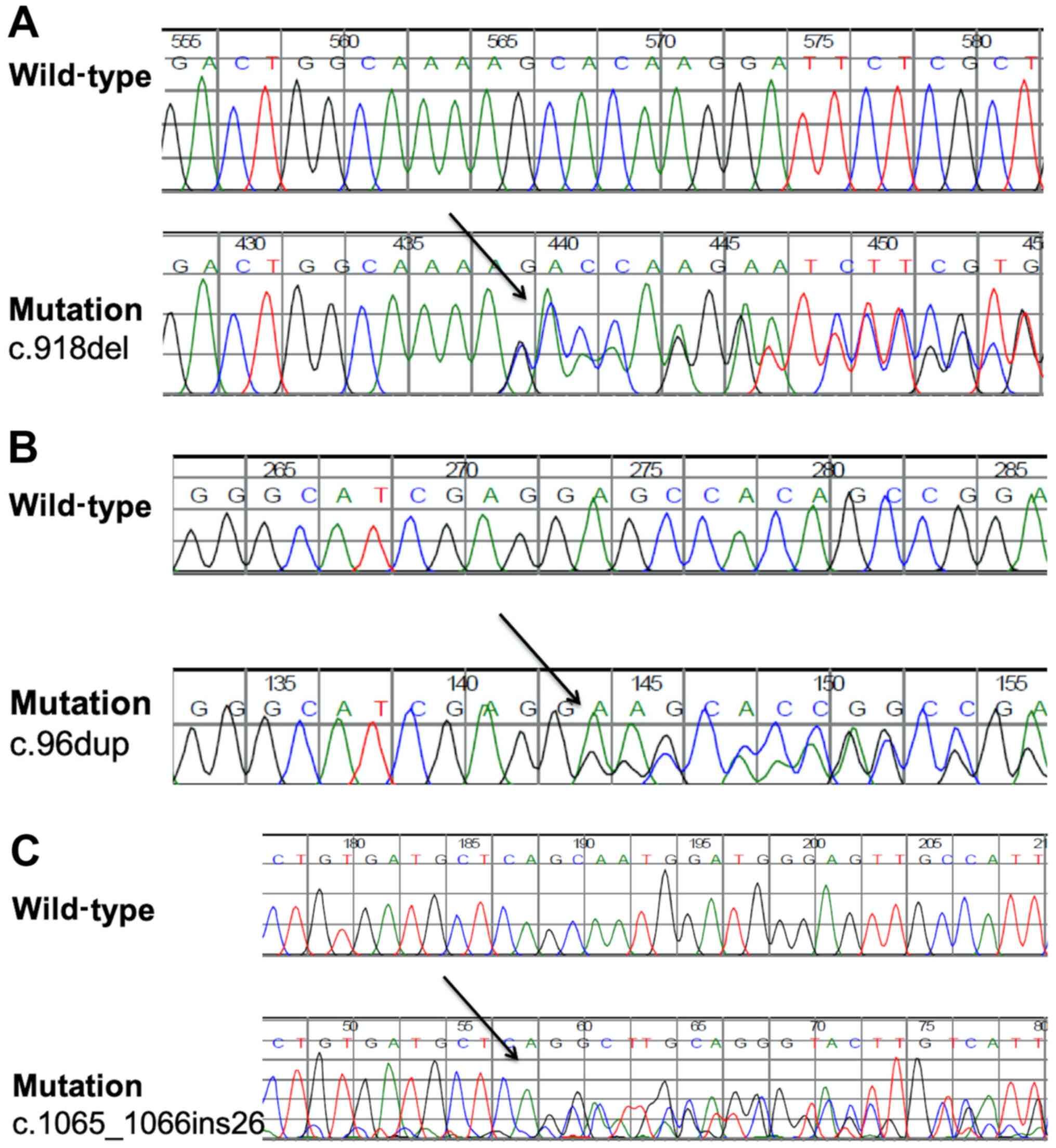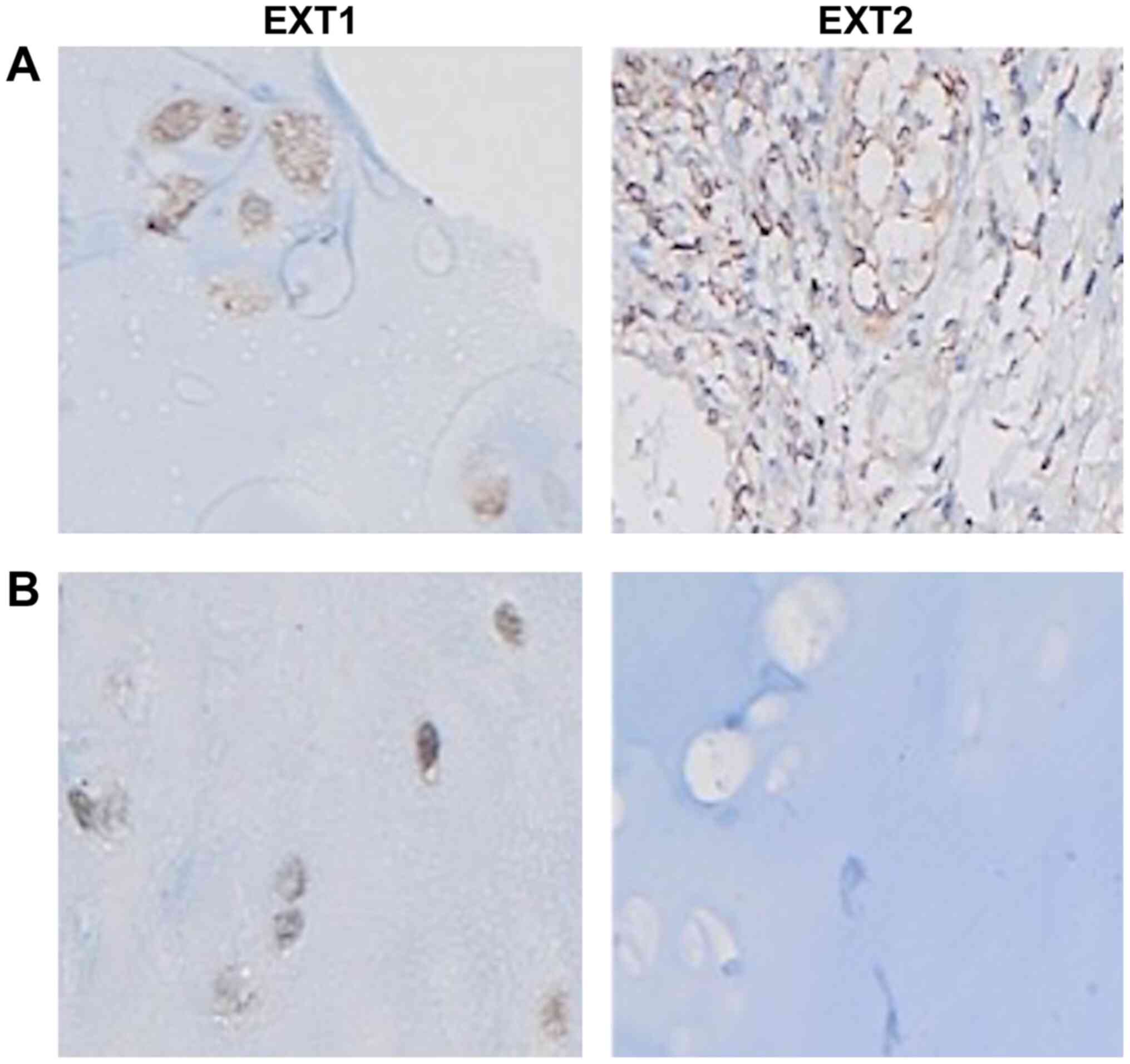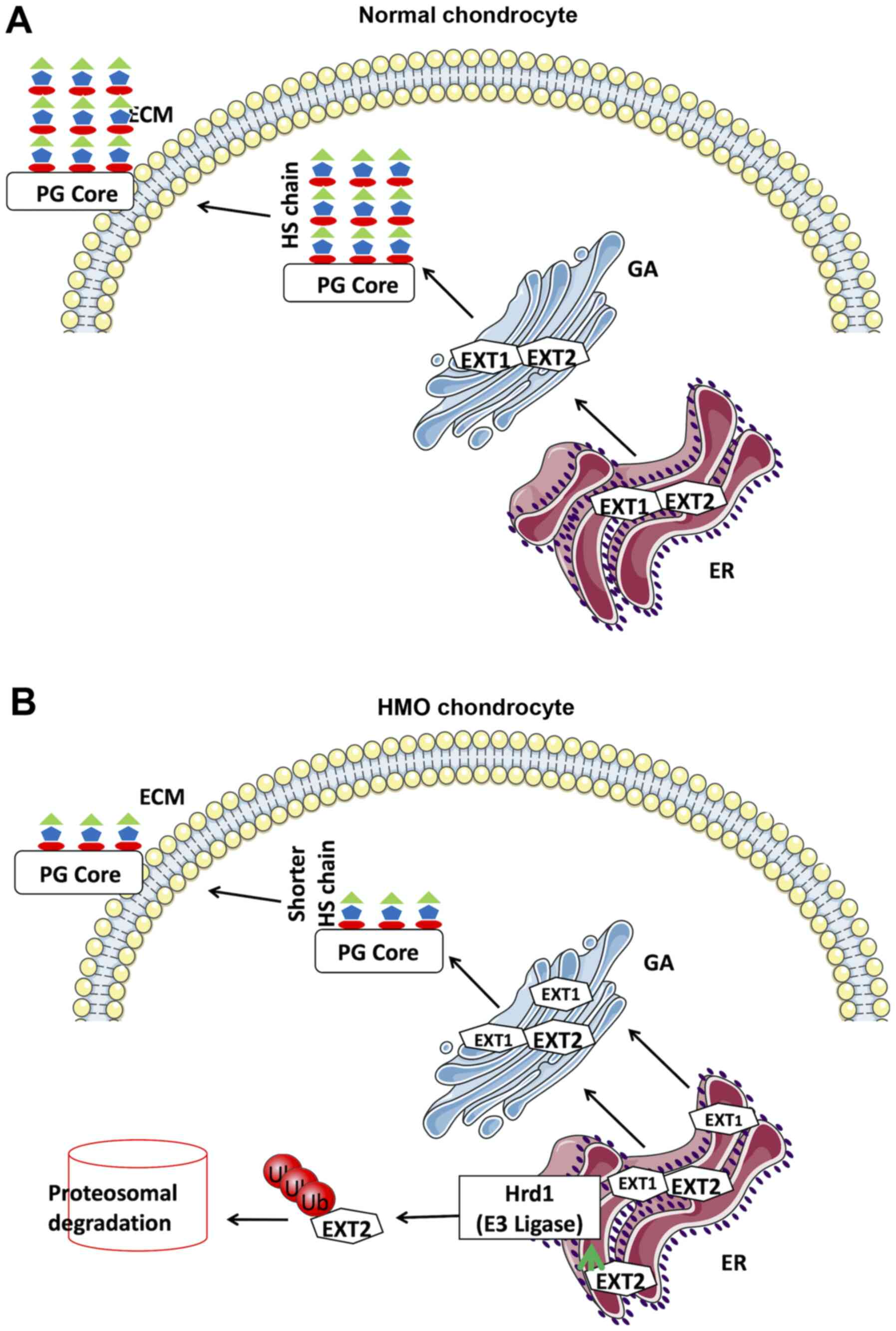|
1
|
Darienzo A, Andreani L, Sacchetti F,
Colangeli S and Capanna R: Hereditary multiple exostoses: Current
insights. Orthop Res Rev. 11:199–211. 2019.PubMed/NCBI
|
|
2
|
Hakim DN, Pelly T, Kulendran M and Caris
JA: Benign tumours of the bone: A review. J Bone Oncol. 4:37–41.
2015. View Article : Google Scholar : PubMed/NCBI
|
|
3
|
Bovée JV: Multiple osteochondromas.
Orphanet J Rare Dis. 3:32008. View Article : Google Scholar : PubMed/NCBI
|
|
4
|
Mohaidat ZM, Saleh AA, Al-Omari MH,
Obeidat AA and Khasawneh RA: Osteochondroma in Jordanian Patients:
Clinical manifestations and management. J Clin Diagnostic Res.
12:RC11–RC15. 2018.
|
|
5
|
Beltrami G, Ristori G, Scoccianti G,
Tamburini A and Capanna R: Hereditary multiple exostoses: A review
of clinical appearance and metabolic pattern. Clin Cases Miner Bone
Metab. 13:110–118. 2016.PubMed/NCBI
|
|
6
|
de Souza AM and Bispo Júnior RZ:
Osteochondroma: Ignore or investigate? Rev Bras Ortop. 49:555–564.
2014. View Article : Google Scholar : PubMed/NCBI
|
|
7
|
Jennes I, Pedrini E, Zuntini M, Mordenti
M, Balkassmi S, Asteggiano CG, Casey B, Bakker B, Sangiorgi L and
Wuyts W: Multiple osteochondromas: Mutation update and description
of the multiple osteochondromas mutation database (MOdb). Hum
Mutat. 30:1620–1627. 2009. View Article : Google Scholar : PubMed/NCBI
|
|
8
|
Zak BM, Crawford BE and Esko JD:
Hereditary multiple exostoses and heparan sulfate polymerization.
Biochim Biophys Acta. 1573:346–355. 2002. View Article : Google Scholar : PubMed/NCBI
|
|
9
|
Busse-Wicher M, Wicher KB and
Kusche-Gullberg M: The extostosin family: Proteins with many
functions. Matrix Biol. 35:25–33. 2014. View Article : Google Scholar : PubMed/NCBI
|
|
10
|
Mordenti M, Ferrari E, Pedrini E, Fabbri
N, Campanacci L, Muselli M and Sangiorgi L: Validation of a new
multiple osteochondromas classification through Switching Neural
Networks. Am J Med Genet Part A. 161A:556–560. 2013. View Article : Google Scholar : PubMed/NCBI
|
|
11
|
Fusco C, Nardella G, Fischetto R, Copetti
M, Petracca A, Annunziata F, Augello B, DAsdia MC, Petrucci S,
Mattina T, et al: Mutational spectrum and clinical signatures in
114 families with hereditary multiple osteochondromas: Insights
into molecular properties of selected exostosin variants. Hum Mol
Genet. 28:2133–2142. 2019. View Article : Google Scholar : PubMed/NCBI
|
|
12
|
Bali DS, Goldstein JL, Banugaria S, Dai J,
Mackey J, Rehder C and Kishnani PS: Predicting cross-reactive
immunological material (CRIM) status in Pompe disease using GAA
mutations: Lessons learned from 10 years of clinical laboratory
testing experience. Am J Med Genet Part C Semin Med Genet.
160C:40–49. 2012. View Article : Google Scholar : PubMed/NCBI
|
|
13
|
Santos SCL, Rizzo IMPO, Takata RI,
Speck-Martins CE, Brum JM and Sollaci C: Analysis of mutations in
EXT1 and EXT2 in Brazilian patients with multiple osteochondromas.
Mol Genet Genomic Med. 6:382–392. 2018. View Article : Google Scholar : PubMed/NCBI
|
|
14
|
Jäger M, Westhoff B, Portier S, Leube B,
Hardt K, Royer-Pokora B, Gossheger G and Krauspe R: Clinical
outcome and genotype in patients with hereditary multiple
exostoses. J Orthop Res. 25:1541–1551. 2007. View Article : Google Scholar : PubMed/NCBI
|
|
15
|
Porter DE, Lonie L, Fraser M, Dobson-Stone
C, Porter JR, Monaco AP and Simpson AH: Severity of disease and
risk of malignant change in hereditary multiple exostoses. A
genotype-phenotype study. J Bone Joint Surg Br. 86:1041–1046. 2004.
View Article : Google Scholar : PubMed/NCBI
|
|
16
|
Saglik Y, Altay M, Unal VS, Basarir K and
Yildiz Y: Manifestations and management of osteochondromas: A
retrospective analysis of 382 patients. Acta Orthop Belg.
72:748–755. 2006.PubMed/NCBI
|
|
17
|
Li Y, Wang J, Wang Z, Tang J and Yu T: A
genotype-phenotype study of hereditary multiple exostoses in
forty-six Chinese patients. BMC Med Genet. 18:1262017. View Article : Google Scholar : PubMed/NCBI
|
|
18
|
Francannet C, Cohen-Tanugi A, Le Merrer M,
Munnich A, Bonaventure J and Legeai-Mallet L: Genotype-phenotype
correlation in hereditary multiple exostoses. J Med Genet.
38:430–434. 2001. View Article : Google Scholar : PubMed/NCBI
|
|
19
|
Delgado MA, Martinez-Domenech G, Sarrión
P, Urreizti R, Zecchini L, Robledo HH, Segura F, De Kremer RD,
Balcells S, Grinberg D and Asteggiano CG: A broad spectrum of
genomic changes in latinamerican patients with EXT1/EXT2-CDG. Sci
Rep. 4:64072014. View Article : Google Scholar : PubMed/NCBI
|
|
20
|
Pedrini E, Jennes I, Tremosini M, Milanesi
A, Mordenti M, Parra A, Sgariglia F, Zuntini M, Campanacci L,
Fabbri N, et al: Genotype-phenotype correlation study in 529
patients with multiple hereditary exostoses: Identification of
‘protective’ and ‘risk’ factors. J Bone Joint Surg Am.
93:2294–2302. 2011. View Article : Google Scholar : PubMed/NCBI
|
|
21
|
Sarrión P, Sangorrin A, Urreizti R,
Delgado A, Artuch R, Martorell L, Armstrong J, Anton J, Torner F,
Vilaseca MA, et al: Mutations in the EXT1 and EXT2 genes in Spanish
patients with multiple osteochondromas. Sci Rep. 3:13462013.
View Article : Google Scholar : PubMed/NCBI
|
|
22
|
Heinritz W, Hüffmeier U, Strenge S,
Miterski B, Zweier C, Leinung S, Bohring A, Mitulla B, Peters U and
Froster UG: New mutations of EXT1 and EXT2 genes in German patients
with multiple osteochondromas. Ann Hum Genet. 73(Pt 3):283–291.
2009. View Article : Google Scholar
|
|
23
|
Alvarez C, Tredwell S, De Vera M and
Hayden M: The genotype-phenotype correlation of hereditary multiple
exostoses. Clin Genet. 70:122–130. 2006. View Article : Google Scholar : PubMed/NCBI
|
|
24
|
Jennes I, Entius MM, Van Hul E, Parra A,
Sangiorgi L and Wuyts W: Mutation screening of EXT1 and EXT2 by
denaturing high-performance liquid chromatography, direct
sequencing analysis, fluorescence in situ hybridization, and a new
multiplex ligation-dependent probe amplification probe set in
patients with multiple osteochondromas. J Mol Diagn. 10:85–92.
2008. View Article : Google Scholar : PubMed/NCBI
|
|
25
|
Cousminer DL, Arkader A, Voight BF,
Pacifici M and Grant SFA: Assessing the general population
frequency of rare coding variants in the EXT1 and EXT2 genes
previously implicated in hereditary multiple exostoses. Bone.
92:196–200. 2016. View Article : Google Scholar : PubMed/NCBI
|
|
26
|
Vink GR, White SJ, Gabelic S, Hogendoorn
PC, Breuning MH and Bakker E: Mutation screening of EXT1 and EXT2
by direct sequence analysis and MLPA in patients with multiple
osteochondromas: Splice site mutations and exonic deletions account
for more than half of the mutations. Eur J Hum Genet. 13:470–474.
2005. View Article : Google Scholar : PubMed/NCBI
|
|
27
|
Szuhai K, Jennes I, De Jong D, Bovée JV,
Wiweger M, Wuyts W and Hogendoorn PC: Tiling resolution array-CGH
shows that somatic mosaic deletion of the EXT gene is causative in
EXT gene mutation negative multiple osteochondromas patients. Hum
Mutat. 32:E2036–E2049. 2011. View Article : Google Scholar : PubMed/NCBI
|
|
28
|
Waaijer CJ, Winter MG, Reijnders CM, de
Jong D, John Ham S, Bovée JV and Szuhai K: Intronic deletion and
duplication proximal of the EXT1 gene: A novel causative mechanism
for multiple osteochondromas. Genes Chromosomes Cancer. 52:431–436.
2013. View Article : Google Scholar : PubMed/NCBI
|
|
29
|
Hong G, Guo X, Yan W, Li Q, Zhao H, Ma P
and Hu X: Identification of a novel mutation in the EXT1 gene from
a patient with multiple osteochondromas by exome sequencing. Mol
Med Rep. 15:657–664. 2017. View Article : Google Scholar : PubMed/NCBI
|
|
30
|
Zhang H, Ping XL, Lee PK, Wu XL, Yao YJ,
Zhang MJ, Silvers DN, Ratner D, Malhotra R, Peacocke M and Tsou HC:
Role of PTCH and p53 genes in early-onset basal cell carcinoma. Am
J Pathol. 158:381–385. 2001. View Article : Google Scholar : PubMed/NCBI
|
|
31
|
Wu Y, Xing X, Xu S, Ma H, Cao L, Wang S
and Luo Y: Novel and recurrent mutations in the EXT1 and EXT2 genes
in Chinese kindreds with multiple osteochondromas. J Orthop Res.
31:1492–1499. 2013. View Article : Google Scholar : PubMed/NCBI
|
|
32
|
Liu H, Wu S, Duan L, Zhu W, Zhang S, Hu X,
Jia W, Yang G, Liu C, Li W, et al: Identification of a novel EXT1
mutation in patients with hereditary multiple exostosis by exome
sequencing. Oncol Rep. 33:547–552. 2015. View Article : Google Scholar : PubMed/NCBI
|
|
33
|
Zhang F, Liang J, Guo X, Zhang Y, Wen Y,
Li Q, Zhang Z, Ma W, Dai L, Liu X, et al: Exome sequencing and
functional analysis identifies a novel mutation in EXT1 gene that
causes multiple osteochondromas. PLoS One. 8:e723162013. View Article : Google Scholar : PubMed/NCBI
|
|
34
|
Cheung PK, McCormick C, Crawford BE, Esko
JD, Tufaro F and Duncan G: Etiological point mutations in the
hereditary multiple exostoses gene EXT1: A functional analysis of
heparan sulfate polymerase activity. Am J Hum Genet. 69:55–66.
2001. View
Article : Google Scholar : PubMed/NCBI
|
|
35
|
Hameetman L, David G, Yavas A, White SJ,
Taminiau AH, Cleton-Jansen AM, Hogendoorn PC and Bovée JV:
Decreased EXT expression and intracellular accumulation of heparan
sulphate proteoglycan in osteochondromas and peripheral
chondrosarcomas. J Pathol. 211:399–409. 2007. View Article : Google Scholar : PubMed/NCBI
|
|
36
|
McCormick C, Duncan G, Goutsos KT and
Tufaro F: The putative tumor suppressors EXT1 and EXT2 form a
stable complex that accumulates in the Golgi apparatus and
catalyzes the synthesis of heparan sulfate. Proc Natl Acad Sci USA.
97:668–673. 2000. View Article : Google Scholar : PubMed/NCBI
|
|
37
|
Kobayashi S, Morimoto K, Shimizu T,
Takahashi M, Kurosawa H and Shirasawa T: Association of EXT1 and
EXT2, hereditary multiple exostoses gene products, in Golgi
apparatus. Biochem Biophys Res Commun. 268:860–867. 2000.
View Article : Google Scholar : PubMed/NCBI
|
|
38
|
Lee KA, Hammerle LP, Andrews PS, Stokes
MP, Mustelin T, Silva JC, Black RA and Doedens JR: Ubiquitin ligase
substrate identification through quantitative proteomics at both
the protein and peptide levels. J Biol Chem. 286:41530–41538. 2011.
View Article : Google Scholar : PubMed/NCBI
|
|
39
|
Ernst R, Claessen JH, Mueller B, Sanyal S,
Spooner E, van der Veen AG, Kirak O, Schlieker CD, Weihofen WA and
Ploegh HL: Enzymatic blockade of the ubiquitin-proteasome pathway.
PLoS Biol. 8:e10006052011. View Article : Google Scholar : PubMed/NCBI
|
|
40
|
Hall CR, Cole WG, Haynes R and Hecht JT:
Reevaluation of a genetic model for the development of exostosis in
hereditary multiple exostosis. Am J Med Genet. 112:1–5. 2002.
View Article : Google Scholar : PubMed/NCBI
|
|
41
|
Reijnders CM, Waaijer CJ, Hamilton A,
Buddingh EP, Dijkstra SP, Ham J, Bakker E, Szuhai K, Karperien M,
Hogendoorn PC, et al: No haploinsufficiency but loss of
heterozygosity for EXT in multiple osteochondromas. Am J Pathol.
177:1946–1957. 2010. View Article : Google Scholar : PubMed/NCBI
|
|
42
|
Busse M and Kusche-Gullberg M: In vitro
polymerization of heparan sulfate backbone by the EXT proteins. J
Biol Chem. 278:41333–41337. 2003. View Article : Google Scholar : PubMed/NCBI
|
|
43
|
Knudson AG Jr: Mutation and cancer:
Statistical study of retinoblastoma. Proc Natl Acad Sci USA.
68:820–823. 1971. View Article : Google Scholar : PubMed/NCBI
|



















